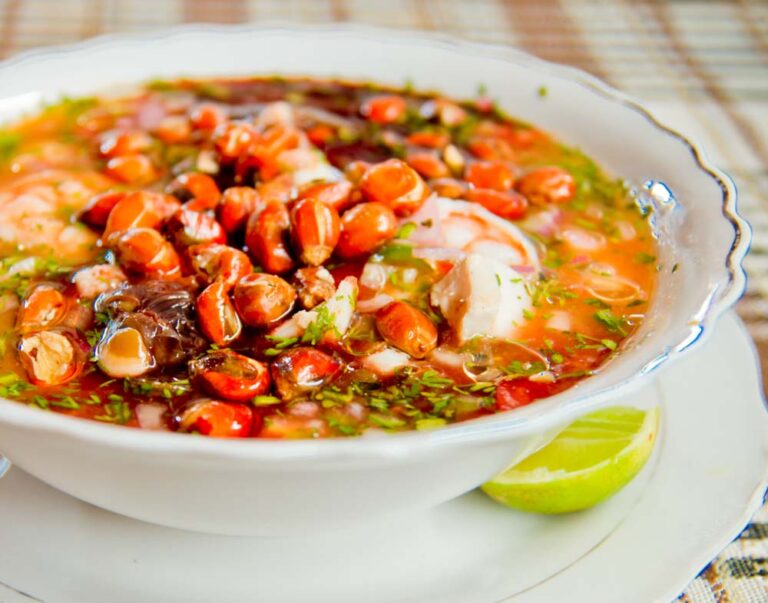Introduction: Ecuadorian cuisine
Ecuadorian cuisine is a reflection of the country’s diverse geography and cultural heritage. The cuisine is heavily influenced by the Andean, Amazonian, and coastal regions, resulting in a wide range of dishes that showcase the use of local ingredients and cooking techniques.
From hearty soups, stews, and meat dishes to fresh seafood and tropical fruits, Ecuadorian cuisine has something to offer for every palate. In this article, we explore the main ingredients used in Ecuadorian dishes and the traditional and fusion dishes that represent the country’s culinary identity.
Staple ingredients in Ecuadorian cooking
The staples of Ecuadorian cooking are rice, beans, plantains, and corn. These ingredients form the foundation of many traditional dishes like ceviche, llapingachos, and encebollado. Rice is often served alongside meat dishes and is used to make arroz con pollo (rice with chicken) and arroz con menestra (rice with lentil stew). Beans, on the other hand, are used to make dishes like locro de papas (potato soup with beans) and churrasco con frijoles (steak with beans).
Plantains are a versatile ingredient that can be used in both sweet and savory dishes. They are often fried or mashed and used as a side dish or a main ingredient in dishes like bolón de verde (mashed plantain stuffed with cheese and meat). Corn is also a staple ingredient in Ecuadorian cooking and is used to make dishes like humitas (corn tamales) and choclo con queso (boiled corn with cheese).
Indigenous crops in Ecuadorian dishes
Ecuador is blessed with a diverse range of indigenous crops like quinoa, amaranth, and chocho that have been used in traditional dishes for centuries. Quinoa, in particular, has gained popularity in recent years for its health benefits and is used in dishes like quinoa soup and quinoa salad. Amaranth is a gluten-free grain that is used to make beverages, porridge, and bread. Chocho, a legume native to the Andean region, is used to make stews, salads, and soups.
Meat and seafood used in Ecuadorian cuisine
Ecuadorian cuisine features a range of meats like beef, pork, and chicken as well as seafood like shrimp, fish, and octopus. Seafood is particularly popular along the coast, where dishes like ceviche, encocado (seafood stew with coconut milk), and pescado frito (fried fish) are widely enjoyed. Meat dishes like hornado (roast pork) and seco de chivo (goat stew) are popular in the highlands, while grilled meats like churrasco (grilled steak) and carne asada (grilled beef) are enjoyed throughout the country.
Flavors and spices in Ecuadorian dishes
Ecuadorian cuisine is known for its bold flavors and use of spices like cumin, coriander, and achiote. Achiote, also known as annatto, is a spice made from the seeds of the achiote tree and is used to give dishes a bright orange color and a slightly sweet, earthy flavor. Other common spices used in Ecuadorian cooking include garlic, onion, and oregano.
Popular fruits and vegetables in Ecuadorian cuisine
Ecuador is home to a wide variety of tropical fruits like papaya, pineapple, and mango as well as unique fruits like naranjilla and guanabana. These fruits are often used in desserts like helado de paila (fruit sorbet) and as toppings for breakfast dishes like yogurt and granola. Vegetables like potatoes, corn, and yucca are also widely used in Ecuadorian cuisine and are often featured in hearty stews and soups.
Traditional Ecuadorian dishes and their ingredients
Some of the most popular traditional dishes in Ecuadorian cuisine include ceviche (seafood marinated in citrus juice), locro de papas (potato soup), and empanadas (stuffed pastries). Ceviche typically contains shrimp or fish, red onion, cilantro, and lime juice, while locro de papas is made with potatoes, cheese, and avocado. Empanadas can be filled with a variety of ingredients like meat, cheese, or vegetables and are often served as a snack or appetizer.
Fusion cuisine in Ecuador and its ingredients
In recent years, Ecuadorian chefs have been experimenting with fusion cuisine, combining traditional Ecuadorian ingredients with flavors and techniques from other cuisines. Some popular fusion dishes include sushi with Ecuadorian toppings like mango and avocado, and fusions of Ecuadorian and Peruvian cuisines like causa rellena (a mashed potato dish stuffed with seafood or chicken). These fusion dishes often incorporate ingredients like soy sauce, wasabi, and ginger to create unique flavor profiles.

